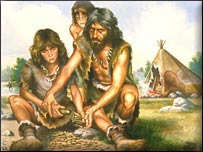A Twist in 'Hobbit' Human Story
06/09/06
 The "Hobbit"-like human was smart enough to make stone tools despite its small brain, according to research. The "Hobbit"-like human was smart enough to make stone tools despite its small brain, according to research.
Sharpened flints found on the remote Indonesian island where it lived suggest the human "cousin" inherited tool-making skills from its ancestors.
Some have claimed its brain was too tiny to perform the complex tasks seen as a hallmark of human culture.
The study in Nature backs the view that the Hobbit is a new species rather than a modern human with a brain disease.
"People have said that the brain size was way too small for them to be capable of any sort of sophisticated culture, but this might not have been the case," said chief researcher Adam Brumm, of the Australian National University in Canberra, Australia.
"The brain size was very small but it would have been capable of what we call culture. It's an aspect of humanity we don't see in the likes of chimps and other great apes."
Heated debate
.jpg) The discovery on the Indonesian island of Flores of the remains of an ancient diminutive people caused a stir in the scientific world in 2004. The discovery on the Indonesian island of Flores of the remains of an ancient diminutive people caused a stir in the scientific world in 2004.
The team that made the initial find said it represented a new branch of humanity's family tree.
The researchers believe the 1m-tall (3ft) people, Homo floresiensis, evolved from an unknown small-bodied, small-brained ancestor, which they think became small in stature to cope with the limited supply of food on the island.
The tiny humans are thought to have survived until about 12,000 years ago, when a volcanic eruption devastated the region.
The discovery was hailed as one of the most significant fossil finds for more than a century. However, a minority of scientists disagree.
They believe that rather than being a completely new species, the Hobbit was merely a modern human that had microcephaly, a congenital disorder that stunts brain growth.
Vital clues
All scientists have to go on are skeletal remains found among a scattering of flint tools in Flores' Liang Bua cave.
Some have argued that the tools are too advanced to have been made by a creature with such a small brain and must have been made later in history by a more advanced human species.
Now, a joint team of Australian and Indonesian researchers has compared the tools found in the Liang Bua cave with other, much older, artefacts discovered on the island at several different archaeological sites.
They say the tools from different time periods bear striking similarities, suggesting they were made in the same way by a long lineage of ancient humans.
"It's basically the same technology," said Dr Brumm.
"That suggests a continuing tradition of tool making on the island over many hundreds of thousands of years."
Time gap
The authors believe the Hobbit inherited tool-making skills from ancestors who lived on the island from about 800,000 years ago.
"The tools themselves are quite simple," said Dr Brumm. "The hominids were basically striking pieces of stone off volcanic cobbles. It was a very simple manufacturing process."
The implements may have been used to process plants for food, slash animal skins or carve wooden tools, although no-one is certain.
The data is unlikely to convince all scientists, however, not least because there is a very long time gap between the tools forged some 800,000 years ago, and those found at Liang Bua.
"We can't guarantee that this material really is related because of the large time gap," said Chris Stringer of the Natural History Museum, UK.
"But it reinforces the argument that the Hobbit really is a descendant of a population that had lived on the island for a very long time.
"This potentially allowed enough time for the unusual features of the Hobbit to develop."
Source: BBC
~~~ Related: Hobbit Sized Race of Humans Found.
Related: Did hobbits live until 200 years ago?
Related: Hobbit, Pygmy, or Microcephalic?
|

